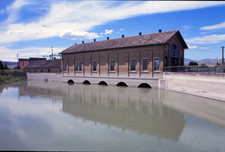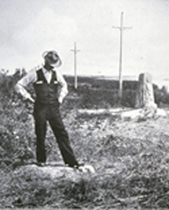New Utah Lake Pumping Plant Is Under Construction
Utah Lake is an integral component of Salt Lake City's water supply
March 27, 2012
LeRoy W. Hooton, Jr.
Utah Lake Pumping Plant viewed from the inlet side. Circa. 1990

At the outlet of Utah Lake in northern Utah County, an historic water landmark is being replaced with a new water facility. The Utah Lake Pumping Plant (also known as the Lehi or Saratoga Pumping Plant) is being replaced after over a century of use.
According to Salt Lake City Public Utilities director Jeff Niermeyer, the aging pumping plant has reached the end of its useful life and it's now necessary to construct a new facility to assure the delivery of irrigation water supply to Salt Lake County. The water is used for farming, secondary water systems and exchange water for municipal supplies. The decision was made to build a new pumping plant and to incorporate a new governance entity to operate it, said Niermeyer, “This new entity, the Utah Lake Water Users Association, Inc. (Association Inc.), will provide equity ownership for the water user members based on stock ownership.” The Association Inc. members are: Salt Lake City, Utah and Salt Lake Canal, North Jordan Irrigation Company, East Jordan Irrigation Company, South Jordan Canal Company, Metropolitan Water District of Salt Lake & Sandy, Jordan Valley Water Conservancy District, Draper Irrigation and Kennecott Utah Copper LLC. It took 5 years of negotiations for the parties to come to an agreement forming the new corporation and financing the construction of the new plant. Niermeyer notes that the efforts were well worth it as the pumping members now have a new plant under construction and a governance organization to operate and maintain it into the future.
Utah Lake is a major source of water for Salt Lake County, including Salt Lake City. The fresh water lake is situated in Utah County and covers 93,000 acres at compromise level. It is a primary irrigation water supply for thousands of acres of farmland in Salt Lake County.
Most of the natural water inflow into the lake comes from the Spanish Fork, Provo and American Fork Rivers. The average annual inflow is 720,000 acre-feet. The average outflow is 346,000 acre-feet, and evaporation accounts for 380,000 acre-feet. In recent years, water has been imported into the lake from the Colorado River by virtue of the Central Utah Project in exchange for Provo River water stored in the Jordanelle Reservoir.
The Jordan River is the outlet for the lake, flowing in a northerly direction to the Great Salt Lake. It appears that the earliest dam on the Jordan River was constructed in the year 1859 by Ferimortz Little and others to irrigate lands on the west side of the river. Over the years there have been controversies over the placement of dams on the Jordan River and flooding the lands surrounding the lake. In 1885, a "Compromise Agreement" was negotiated which settled the water elevation of the lake; however, in 1986 as part of a lawsuit settlement agreement, the district court established the elevation of the lake pursuant to the "Utah Lake Jordan River Flood Management Plan" at 4489.0455 USGS datum.
|
The Utah Lake Pumping Plant was originally owned by the Associated Canal Companies, consisting of the Utah and Salt Lake Canal Company, the East Jordan Irrigation Company, the South Jordan Irrigation Company, the North Jordan Irrigation Company and Salt Lake City. The Associate Canal Companies and governing board, the Board of Canal Presidents were bound together by an informal partnership. Over time additional water users were allowed to utilize the pumping facilities by contract.
During the early 20th century the epochal pumping facility stood alone in pumping capacity. According to the Salt Lake City 1907 Annual Report, “The pumping plant was the largest plant in the United States ... capable of delivering 700 cubic feet per second...”
Salt Lake City has paramount interests in Utah Lake:
1. Salt Lake City has decreed water rights in Utah Lake, and ownership of stock in the East Jordan Irrigation Company. Utah Lake water is conveyed to Salt Lake City's service area via the Jordan & Salt Lake Canal and East Jordan Canal. It is part owner in the Utah Lake Pumping plant, Turner Dam and Joint Dam on the Jordan River. These rights provide the means for exchanging Utah Lake water for water in Parleys, Mill Creek, Big and Little Cottonwood streams, providing 60 percent of the water supply within the City's municipal service area.
2. Salt Lake City formed the Metropolitan Water District of Salt Lake City in 1935 to participate in the Provo River Project and the Deer Creek Reservoir. A 1958 agreement with the Utah Lake Distributing Company allows MWD to use an additional 15,200 shares of Provo River Projects rights by exchanging Utah Lake water with the company. This water is available to Salt Lake City as part of MWD's municipal water supply.
Steve Clyde of Clyde, Snow and Sessions was hired to help create a new entity to replace the century-old Association of Canals. One of the first steps was to determine the value of the existing assets. A value of $5 million was determined for the existing real estate and facilities. This value was used for a credit against the cost of the new pumping plant in behalf of the original owners.
In July 2011, the new Association Inc. was incorporated to replace the Association of Canals. This new organization will raise the necessary capital to construct the new pumping plant and govern the on-going operation and maintenance of this facility. The new Association Inc. does not own any water rights and acts only as a water distribution entity. Each of the members has their own water rights. Stock was issued based on pumping capacity to the 9 participants based on one-share of stock for every one-cubic feet per second of pumping capacity. The stock ownership of each entity will be proportionately assessed for both the capital costs to construct the new pumping plant and on-going O&M expenses.
|
The engineering design of the new pumping plant is being conducted by Bowen & Collins Associates. Engineer Jason C. Luettinger, PE said the new building will be constructed directly east of the existing structure. The existing structure will remain for historic purposes. The new facility will house four new horizontal axial flow pumps with siphon recovery each rated at 200 cubic feet per second with 1,400 combined horsepower. There is space for an additional pump to be installed in the future.
Luettinger, noted that because of the location of the new building, the water flow does not have a straight-line approach into the fore-bay structure. This required additional engineering measures in order to obtain maximum pumping efficiency. To accomplish this it was decided to hire the Utah State Research Laboratory to physically construct a 1/9.8 model to ascertain the optimum design of the new facility. This resulted in cost savings to the final design and construction that far exceeded the cost of the modeling. This extra effort will assure that the pumps will operate at maximum efficiency and deliver the volumes required by the newly incorporated association members.
Work is now underway on the new pumping facility. Allstate Construction Company was awarded the contract last February with a bid of $6.7 million with one year to complete the work. One of the first construction activities was to remove the historic compromise monument. It was located on the site of the new pumping plant, which revealed that beneath the monument was a huge 23,000 pound concrete block. Luettinger quipped, “With the water users fighting all these years about the lake's compromise elevation, somebody decided that with a lot of concrete nobody would move it again.”

